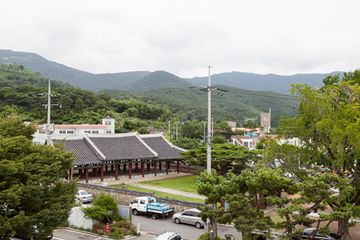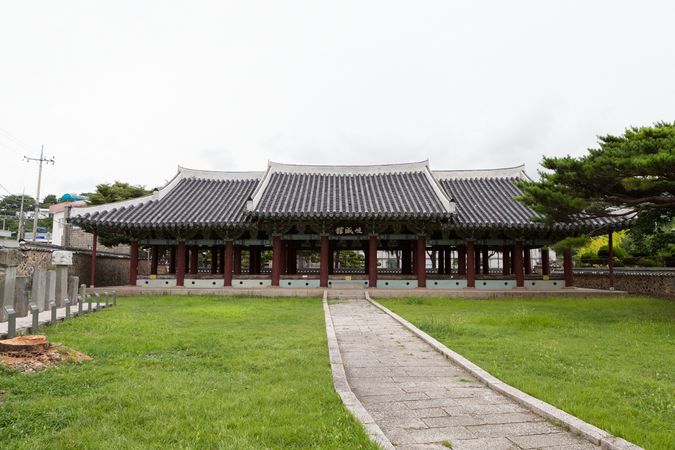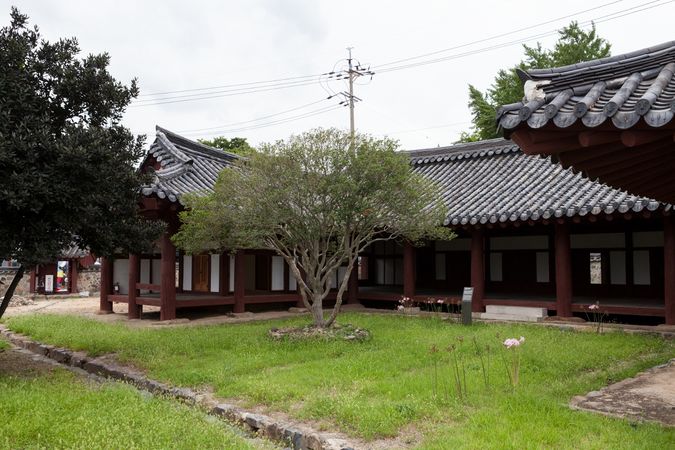"거제현 관아"의 두 판 사이의 차이
| 65번째 줄: | 65번째 줄: | ||
Guesthouses, called ''gaeksa'' in Korean, were built nearby local government offices during the Joseon period (1392-1910). The guesthouse includes a shrine in the center to hold a wooden tablet symbolizing the king and two rooms to either side which were used as temporary lodging facilities for officials visiting from other regions. The wooden tablet enshrined in each local guesthouse exhibited the king’s sovereignty across the country. To acknowledge this sovereignty, the local magistrate and other officials regularly performed a ceremony in which they bowed deeply toward the royal capital. | Guesthouses, called ''gaeksa'' in Korean, were built nearby local government offices during the Joseon period (1392-1910). The guesthouse includes a shrine in the center to hold a wooden tablet symbolizing the king and two rooms to either side which were used as temporary lodging facilities for officials visiting from other regions. The wooden tablet enshrined in each local guesthouse exhibited the king’s sovereignty across the country. To acknowledge this sovereignty, the local magistrate and other officials regularly performed a ceremony in which they bowed deeply toward the royal capital. | ||
| − | Giseonggwan was originally built in | + | Giseonggwan was originally built in 1453 nearby Gohyeonseong Fortress as a main administrative building of Geoje-hyeon Government Office. However, the local government office was destroyed during the Japanese invasions of 1592-1598. In 1663, when the local government office was rebuilt in this location, a new Giseonggwan Hall was also built and served as a guesthouse. This building came to be used as an elementary school building from 1911. The entire building was dismantled and renovated in 1976. |
| − | This building is regarded as one of the four most iconic | + | This building is regarded as one of the four most iconic traditional buildings built during the Joseon period in Gyeongsangnam-do region, along with Sebyeonggwan Hall in Tongyeong (National Treasure No. 305), Yeongnamnu Pavilion in Miryang (Treasure No. 147), and Chokseongnu Pavilion in Jinju (Gyeongsangnam-do Cultural Heritage Material No. 8). |
====Jilcheong Office==== | ====Jilcheong Office==== | ||
| 85번째 줄: | 85번째 줄: | ||
객사는 조선시대에 고을 관아에 설치했다. 객사는 가운데에 왕의 전패를 모신 정당이 있고 좌우 양쪽에 숙소로 사용되던 익실이 있다. 객사에 모셔진 전패는 왕의 통치권을 상징하는 것이다. 이러한 통치권을 바탕으로 고을 수령과 관리들은 궁궐을 향해 절하는 망궐례를 행했다. | 객사는 조선시대에 고을 관아에 설치했다. 객사는 가운데에 왕의 전패를 모신 정당이 있고 좌우 양쪽에 숙소로 사용되던 익실이 있다. 객사에 모셔진 전패는 왕의 통치권을 상징하는 것이다. 이러한 통치권을 바탕으로 고을 수령과 관리들은 궁궐을 향해 절하는 망궐례를 행했다. | ||
| − | 기성관은 원래 | + | 기성관은 원래 1453년 고현성에 주요 행정건물로 세워졌다. 그러나 임진왜란 때 소실되었고, 1663년 이곳에 옮겨진 후에는 객사로 지어졌다. 1911년부터 초등학교 교사로 사용되었고, 1976년 전체 건물을 해체 복원하였다. |
| − | 기성관은 통영 세병관(국보 제305호), 밀양 영남루(보물 제147호), 진주 촉석루(경상남도 문화재자료 제8호)와 함께 경상남도의 4대 | + | 기성관은 통영 세병관(국보 제305호), 밀양 영남루(보물 제147호), 진주 촉석루(경상남도 문화재자료 제8호)와 함께 경상남도의 조선시대 4대 건축물 중 하나로 꼽힌다. |
====질청==== | ====질청==== | ||
2020년 10월 18일 (일) 15:56 판
| 거제현 관아 Geoje-hyeon Government Office |
|
 거제현 관아, 국가문화유산포털, 문화재청. |
|
| 대표명칭 | 거제현 관아 |
|---|---|
| 영문명칭 | Geoje-hyeon Government Office |
| 한자 | 巨濟縣 官衙 |
| 주소 | 경상남도 거제시 거제면 동상리 546등 일원 |
| 지정번호 | 사적 제484호 |
| 지정일 | 2007년 7월 31일 |
| 분류 | 유적건조물/정치국방/궁궐·관아/궁궐 |
| 시대 | 조선시대 |
| 수량/면적 | 7,941㎡ |
| 웹사이트 | 거제현 관아, 국가문화유산포털, 문화재청. |
|
|
|
목차
해설문
국문
종합
거제현 관아는 남해안 일대를 침략하는 왜구를 막기 위해 고현에 설치되었으나, 임진왜란으로 관아의 행정업무를 담당하는 중심 건물인 기성관이 소실되어 1663년(현종 4)에 지금의 거제면으로 옮겨져 왔다.
관아는 진입로-관아건물-안산(安山)이 일직선으로 배치되어 있어 한양의 광화문-경복궁-백악산으로 연결되는 배치와 유사하다.
현재 관아에는 기성관과 부속건물인 질청이 남아 있다. 기성관은 거제현의 객사로 관아의 주요 업무를 담당했던 곳이다. 기성관은 화려한 단청과 웅대한 마루구조로 이루어져 있어 문화재로서의 가치가 높은 곳이라고 할 수 있다. 기성관과 함께 동헌이 있었으나 현재는 거제면사무소가 그 자리에 들어섰다.
조선시대에 제작된 고지도 중 관아의 위치와 건물의 배치를 알 수 있는 자료가 많이 남아있고, 거제현 관아의 경관과 건물의 구조는 조선후기 읍치의 전형적인 모습을 보여주는 자료이므로 역사적 가치를 인정받아 사적으로 지정되었다.
- 질청과 동헌: 질청(秩廳)은 아전들이, 동헌(東軒)은 고을의 수령이 업무를 보는 곳이다.
- 읍치: 조선시대 지방 고을의 중심 공간(治所)이 있는 곳을 말한다.
기성관
기성관은 1470년(성종 원년)에 일반 행정과 군사업무를 총괄할 목적으로 거제현의 중심지인 고현성에 기성관이 세워져 국가기관의 중심건물로서 역할을 하였다. 1593년(선조 26) 한산도에 삼도수군통제영이 설치되면서 기성관은 객사로 이용되었고, 임진왜란으로 인해 고현성이 함락되면서 기성관은 소실되었다. 1663년(현종 4)에 지금의 위치로 옮겨와 다시 지어졌다.
거제현 관아의 기성관은 통영 세병관, 진주 촉석루, 밀양 영남루와 함께 경상남도의 4대 누각 중 하나로 꼽을 수 있다. 기성관은 정면 9칸, 측면 3칸으로 사방이 트인 마루가 있는 웅대한 구조이다. 배흘림기둥의 윗부분에만 장식을 하였으며, 지붕은 3등분하여 중앙은 맞배지붕형태이다. 특히 다른 3개의 누각과 달리 좌우 익실이 있으며, 양끝은 팔작지붕으로 낮추어 만들고 단청을 화려하게 장식하였다. 이는 객사가 임금의 위패를 모시는 장소이기 때문에 임금의 권위를 높이려는 의도가 반영된 것으로 여타의 건축물과 달리 더욱 웅장한 모습을 보여준다.
- 익실(翼室) : 본 건물의 좌우에 딸려 있는 방
질청
질청은 하급 관리들의 사무실이나 서재로 사용되었던 건물로 작청(作廳) 또는 연청(椽廳)이라고도 한다. 동헌과 함께 거제현 관아의 부속 건물이었으나 현재 동헌은 남아 있지 않다.
질청의 건물 구조는 ‘ㄷ’자형으로 되어 있지만 과거의 모습을 담은 거제현 지도에 ‘ㅁ’자형으로 나와 있어 일제강점기 이후 도시화 과정에서 도로와 닿은 앞부분이 철거된 것으로 보인다. 현재 남아있는 것만 27칸이 넘는 대규모의 건물이다. 건물의 중앙부에는 사무를 보는 큰 대청이 있고, 양측에 주거용 방이 있다. 기성관처럼 화려한 장식이 있는 건물은 아니지만 굵은 배흘림기둥과 건물 안팎으로 드러나 있는 건축자재들의 윤곽이 검소하면서도 엄숙함을 느끼게 한다.
질청은 기성관과 함께 조선시대 관아의 전형적인 모습을 보여주는 자료로 역사적 가치를 인정받아 거제현 관아 부속건물로 사적 지정되었다.
- 배흘림기둥: 건물의 조화와 안정을 위하여 기둥 중간 부분의 배가 약간 부르도록 한 건축 양식
영문
Geoje-hyeon Government Office
This was the local government complex established during the Joseon period (1392-1910). The two buildings currently remaining in the complex are a guesthouse called Giseonggwan and a lower officials’ office called Jilcheong. The magistrate’s office, which was located to the left of the complex, was torn down to build Geoje-myeon Office.
The local government was first established in 1422 to deal with Japanese pirates frequently appearing in the southern coastal region. Its office was originally built in today’s Sadeung-ri area and was moved within Gohyeonseong Fortress in 1453, which was constructed near today’s Geoje City Hall. However, the government office was destroyed during the Japanese invasions of 1592-1598 and was reconstructed on the current site in 1663.
In 2007, this government complex was designated as Historic Site No. 484 in recognition of its historical value as it shows the typical architectural structure and layout of local government office of the Joseon period.
Giseonggwan Guesthouse
Guesthouses, called gaeksa in Korean, were built nearby local government offices during the Joseon period (1392-1910). The guesthouse includes a shrine in the center to hold a wooden tablet symbolizing the king and two rooms to either side which were used as temporary lodging facilities for officials visiting from other regions. The wooden tablet enshrined in each local guesthouse exhibited the king’s sovereignty across the country. To acknowledge this sovereignty, the local magistrate and other officials regularly performed a ceremony in which they bowed deeply toward the royal capital.
Giseonggwan was originally built in 1453 nearby Gohyeonseong Fortress as a main administrative building of Geoje-hyeon Government Office. However, the local government office was destroyed during the Japanese invasions of 1592-1598. In 1663, when the local government office was rebuilt in this location, a new Giseonggwan Hall was also built and served as a guesthouse. This building came to be used as an elementary school building from 1911. The entire building was dismantled and renovated in 1976.
This building is regarded as one of the four most iconic traditional buildings built during the Joseon period in Gyeongsangnam-do region, along with Sebyeonggwan Hall in Tongyeong (National Treasure No. 305), Yeongnamnu Pavilion in Miryang (Treasure No. 147), and Chokseongnu Pavilion in Jinju (Gyeongsangnam-do Cultural Heritage Material No. 8).
Jilcheong Office
Jilcheong was an auxiliary building of the local government office during the Joseon period (1392-1910). It was used by lower officials as their office and library. From 1926, it was used as a local registry office, and the current building was dismantled and renovated in 1984.
According to an illustrated map of the Geoje area dating to the 19th century, this building formed a square layout with a courtyard in the middle. The front section of this building is presumed to have been demolished in the early 20th century during the urban development. Currently, this simple yet grand building consists of a wide wooden-floored hall at the center and an under-floor heated room on either side.
영문 해설 내용
종합
거제현 관아는 조선시대에 설립된 지방 관아이다. 현재 관아에 남아있는 두 건물은 객사인 기성관과 하급 관리들의 사무실인 질청이다. 동헌은 관아 왼쪽에 있었으나 현재는 거제면사무소가 그 자리에 들어섰다.
거제현 관아는 남해안 일대를 침략하는 왜구를 막기 위해 1422년에 설치되었다. 관아는 원래 지금의 사등리 지역에 있다가, 1453년 지금의 거제시청 부근에 지어졌던 고현성 안으로 옮겨졌다. 그러나 임진왜란으로 소실되었고 1663년 지금의 위치에 다시 지었다.
조선시대 관아의 전형적인 건물 구조와 배치 등을 보여주는 곳이므로, 역사적 가치를 인정받아 2007년 사적 제484호로 지정되었다.
기성관
객사는 조선시대에 고을 관아에 설치했다. 객사는 가운데에 왕의 전패를 모신 정당이 있고 좌우 양쪽에 숙소로 사용되던 익실이 있다. 객사에 모셔진 전패는 왕의 통치권을 상징하는 것이다. 이러한 통치권을 바탕으로 고을 수령과 관리들은 궁궐을 향해 절하는 망궐례를 행했다.
기성관은 원래 1453년 고현성에 주요 행정건물로 세워졌다. 그러나 임진왜란 때 소실되었고, 1663년 이곳에 옮겨진 후에는 객사로 지어졌다. 1911년부터 초등학교 교사로 사용되었고, 1976년 전체 건물을 해체 복원하였다.
기성관은 통영 세병관(국보 제305호), 밀양 영남루(보물 제147호), 진주 촉석루(경상남도 문화재자료 제8호)와 함께 경상남도의 조선시대 4대 건축물 중 하나로 꼽힌다.
질청
질청은 조선시대 관아의 부속 건물이었다. 관아의 하급 관리들이 사무실이나 서재로 사용하였다. 1926년부터는 등기소로 사용되었으며, 지금의 건물은 1984년에 해체 복원한 것이다.
거제 지역을 기록한 19세기 회화식 지도에 따르면, 질청은 원래 가운데 마당이 있는 ㅁ자형 구조였다. 앞부분은 20세기 도시화 과정에서 철거된 것으로 보인다. 검소하지만 엄숙한 분위기의 이 건물은 가운데 넓은 대청과 양쪽의 온돌방으로 이루어져 있다.

